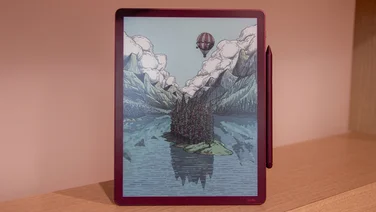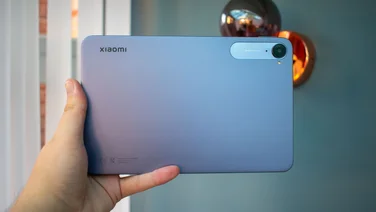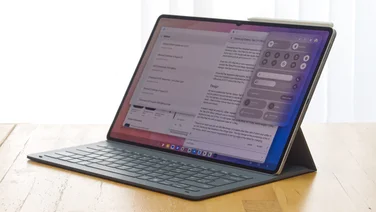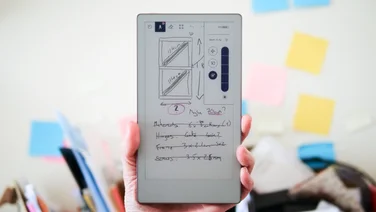To help us provide you with free impartial advice, we may earn a commission if you buy through links on our site. Learn more

The Nvidia Shield Tablet remains a colossally powerful Android gaming tablet that leaves many of its rivals in the dust. In terms of sheer gaming performance very few tablets can compete, and it can also be used to stream PC games from a laptop, PC or the Cloud.
Unsurprisingly, the Shield managed to max out the Ice Storm Extreme 3D benchmark. In the Ice Storm Unlimited benchmark, which is locked to 720p to provide an even test across chipsets, the tablet managed an astronomical score of 27,000. In comparison, this year’s iPad Air 2, which is no slouch, managed 21,548 in the same test. Generously, Nvidia provides a free copy of Trine 2 with the tablet, so you’ll immediately have a good-looking game to show off the tablet’s capabilities.
The Shield’s scorching gaming performance is due to the Nvidia Tegra K1 mobile processor. The Shield’s chip differs from that in the Google Nexus 9 in that it has a quad-core rather than dual-core chip; a 2.2GHz ARM Cortex-A15 CPU paired with an Nvidia Kepler GPU with 192 Nvidia Cuda cores.
If you have a PC or laptop with a compatible Nvidia GeForce GTX graphics card, you can also use Nvidia GameStream to stream games directly to your Nvidia Shield Tablet. You’ll need to have a GeForce GTX 650 or higher card for a desktop, although a GTX 660 or higher is recommended for 1080p/60fps streaming. In terms of laptop GPUs, you’ll need a system equipped with a GeForce GTX 800M, 700M or certain Kepler-based 600M mobile graphics cards.

You can use the optional Shield Tablet Wireless Controller (£50, www.ebuyer.com) to connect to the Shield over a Wi-Fi direct connection rather than Bluetooth. This provides less latency than a Bluetooth connection and also means you can connect up to four controllers to one tablet. The controller has a similar layout to an Xbox controller, so is perfectly suited to console ports. The controller also has an integrated touchpad, volume control buttons, a headset jack and an integrated microphone that lets you use Android’s voice-operated features.
The controller is incredibly well thought out and pairing was a simple process. It’s a must-have accessory if you plan to use the GameStream function. Controllers aren’t as well supported in Android games, so to get around this Nvidia’s Gamepad Mapper can install profiles that let you map touch controls to the controller for compatible games. Not all games are compatible, however; there’s a list at http://shield.nvidia.co.uk.
GameStream will be a useful option if you want to play PC games elsewhere in the house without wanting to move your desktop or laptop. You’ll need to have a suitably fast wireless network for a seamless experience and an 802.11n dual-band router is recommended. It’s also advisable to use the 5GHz band if available. Considering the Shield’s GameStream feature, we were disappointed to see the tablet was limited to dual-band 802.11n rather than the newer, faster 802.11ac standard.
In testing, the GameStream experience worked well on a relatively uncongested 802.11n network. Latency was handled reasonably well, although some input delay was noticeable in first-person shooters. GameStream felt far more seamless when playing Tomb Raider than in a fast twitch-based game like Titanfall. Usefully, you can connect the Shield Tablet to an external display with the Mini HDMI port. You can then put the tablet in Console mode to play either local Android games or for streaming your PC games via GameStream.
Android Marshmallow Update
When it launched, the Nvidia Shield Tablet was one of the first third-party devices to get an update to Android 5.0 Lollipop. Now, it’s been updated to Android 6.0.1 Marshmallow continuing Nvidia’s generally excellent support for its older Android-based devices. The new update brings with it some important additions, such as support for the new Vulkan API. This will bring efficiency improvements and better access to the Shield’s graphics hardware. Otherwise, the 6.0.1 brings the standard additions such as updated emojis. You can also now double tap the Home button to bring up the Shield’s camera app. It’s also worth upgrading for the security enhancements and general bug fixes for the compass and gamepad mapping. You should also get better battery performance with support for Android Doze. The update should now be available as an OTA upgrade.
Originally the Shield Tablet launched with Nvidia Grid, a Cloud gaming service that streams games from Nvidia’s servers. It has since been re-branded as GeForce Now, which alludes to Nvidia’s graphics cards. This brings a Netflix-style gaming subscription service to the Shield that will also be able to take advantage of the controller, providing even more gaming content for the tablet and freeing you from the need to have any additional hardware.
The service was initially free when it was in Beta, but now it has launched properly it costs £7.49 a month with the first 3 months available as a free trial. Not all games are included with the subscription, however, as some are available as ‘Buy & Play Instantly’ and subject to their own cost. The games catalogue available to stream for free has steadilyt been growing but you should see if there are enough titles you’re interested in before parting with any money beyond the free trial. As for how well GeForce Now works, provided you have a fast internet connection it works very well. Frame rates are consistent and you get next to no latency, although hardened fighting game fans might notice some.
The Shield Tablet has an integrated stylus. Removing this from the tablet automatically opens up the DirectStylus shortcut menu, which lets you quickly open apps such as Evernote and Nvidia Dabbler for drawing. It also gives you capture tools such as a lasso to select parts of the screen, capturing full screenshots or writing annotations. It’s possible to use the stylus anywhere in the operating system as well as in apps and games, if you feel the need for more accuracy. For instance, we found playing point and click adventures such as The Walking Dead more enjoyable with the stylus.

The Shield completed our SunSpider JavaScript benchmark in 673.7ms. This is up there with some of the best Android tablets for browser speed. Scrolling through image-dense pages was silky smooth and the tablet was highly responsive when navigating the Android operating system, without any stuttering or delay.
The tablet’s 8in display has a resolution of 1,920×1,200, and a high pixel density of 283ppi. Our display calibrator showed the Shield could produce 79.2% of the sRGB colour gamut, which isn’t quite as high as the Amazon Kindle Fire HDX 8.9 or even the Tesco hudl2, but still above average. The Shield Tablet produced slightly disappointing black levels for a premium tablet, with a score of 0.41cd/m2, and similarly its contrast ratio of 823:1 wasn’t as high as we would have liked.
The display is flanked by two front-facing stereo speakers that include a dual bass reflex port. These speakers produced by far the best audio we have heard from a tablet, with actual bass presence and decent mids and trebles. Stereo separation was also impressive and dialogue in films came through loud and clear. The speakers were also suitably loud enough for you not to always have to use headphones.
The tablet has good overall build quality. The back has a soft-touch, slightly rubbery plastic that makes it easy to hold. Our only real gripe is that the power and volume rocker sit very flat and have little travel to them, making them difficult to press. The tablet has a microSD slot so you can expand the built-in memory.
The base model comes with 16GB of built-in storage for £240, or you can opt for the 32GB model for £300 that also comes with 4G LTE. The inclusion of a 4G modem makes the higher-end model good value if you have a need for always-on internet access. By contrast, upgrading from 16GB to 32GB on the Google Nexus 9 is a difference of £80, and that’s just for the additional storage capacity and no modem. Bear in mind that on the 16GB Shield you’ll have less than 10GB of storage left out of the box, and only certain games and apps support being moved to the SD card, so you’ll only have room for seven or eight of the latest 3D titles.
The Shield has 5-megapixel cameras on the front and back, which was a surprise as the front-facing camera is often less of a priority. However, this particular tablet is able to stream over the Twitch live game streaming service, so having a higher-quality front-facing camera will be a real bonus for anyone looking to provide video commentary.

Both cameras performed surprisingly well. In our outdoor shots, the rear camera produced well-exposed images with good saturation. They could have done with being a touch sharper, but were still respectable. We found the HDR mode made images appear slightly washed-out, however. The front-facing camera was able to provide good exposure under low light indoors, as would be the situation when streaming gaming commentary.
Tablets are becoming ever more of a force to be reckoned when it comes to gaming, with more high-profile titles being developed for slates or ported from consoles. There’s no doubt that Nvidia’s Shield Tablet is the new benchmark for tablet gaming performance. It’s one of the most powerful tablets available and its GameStream options are also a real bonus if you have a compatible graphics card. The Shield will also be the perfect platform for the Grid Cloud gaming service, letting you play the latest titles all over the house without needing any additional gaming hardware.
The Shield’s screen isn’t the best we’ve seen, but it’s reasonable, and the tablet is certainly keenly priced considering its specifications and performance. If you’d like a tablet for gaming which also has strong performance in everyday use, it’s a great buy.






